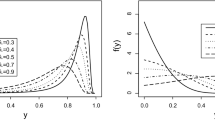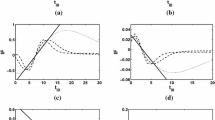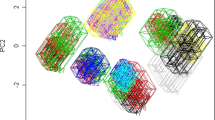Abstract
Some regression models for analyzing relationships between random intervals (i.e., random variables taking intervals as outcomes) are presented. The proposed approaches are extensions of previous existing models and they account for cross relationships between midpoints and spreads (or radii) of the intervals in a unique equation based on the interval arithmetic. The estimation problem, which can be written as a constrained minimization problem, is theoretically analyzed and empirically tested. In addition, numerically stable general expressions of the estimators are provided. The main differences between the new and the existing methods are highlighted in a real-life application, where it is shown that the new model provides the most accurate results by preserving the coherency with the interval nature of the data.


Similar content being viewed by others
References
Billard L, Diday E (2000) Regression analysis for interval-valued data. Data analysis, classification and related methods. In: Kiers HAL et al (eds) Proceedings of 7th conference IFCS, vol 1, pp 369–374
Blanco-Fernández Á, Corral N, González-Rodríguez G (2011) Estimation of a flexible simple linear model for interval data based on set arithmetic. Comput Stat Data Anal 55(9):2568–2578
Blanco-Fernández Á, Colubi A, García-Bárzana M (2013) A set arithmetic-based linear regression model for modelling interval-valued responses through real-valued variables. Inf Sci 247(20):109–122
Boruvka A, Cook RJ (2015) A Cox–Aalen model for interval-censored data. Scand J Stat 42(2):414–426
Boukezzoula R, Galichet S, Bisserier A (2011) A midpoint radius approach to regression with interval data. Int J Approx Reason 52(9):1257–1271
Černý M, Rada M (2011) On the possibilistic approach to linear regression with rounded or interval-censored data. Meas Sci Rev 11(2):34–40
Diamond P (1990) Least squares fitting of compact set-valued data. J Math Anal Appl 147:531–544
D’Urso PP (2003) Linear regression analysis for fuzzy/crisp input and fuzzy/crisp output data. Comput Stat Data Anal 42:47–72
D’Urso PP, Giordani P (2004) A least squares approach to principal component analysis for interval valued data. Chemom Intell Lab 70:179–192
Efron B, Tibshirani R (1993) An introduction to the bootstrap. Chapman & Hall, New York
Freedman DA (1981) Bootstrapping regression models. Ann Stat 9(6):1218–1228
Gil MA, González-Rodríguez G, Colubi A, Montenegro M (2007) Testing linear independence in linear models with interval-valued data. Comput Stat Data Anal 51:3002–3015
Gillis N (2012) Sparse and unique nonnegative matrix factorization through data preprocessing. J Mach Learn Res 13:3349–3386
Golub HG, Van Loan CF (1996) Matrix computations. Johns Hopkins University Press, Baltimore
González-Rodríguez G, Blanco Á, Corral N, Colubi A (2007) Least squares estimation of linear regression models for convex compact random sets. Adv Data Anal Classif 1:67–81
Higham NJ (1996) Accuracy and stability of numerical algorithms. Society for Industrial and Applied Mathematics, Philadelphia
Jahanshahloo GR, Hosseinzadeh Lotfi F, Rostamy Malkhalifeh M, Ahadzadeh Namin M (2008) A generalized model for data envelopment analysis with interval data. Appl Math Model 33:3237–3244
Johnston J (1972) Econometric methods. McGraw-Hill Book Co., New York
Körner R (1997) On the variance of fuzzy random variables. Fuzzy Set Syst 92:83–93
Lauro CN, Palumbo F (2005) Principal component analysis for non-precise data. New developments in classification and data analysis. In: Studies in classification, data analysis and knowledge organization. Springer, pp 173–184
Lemke CE (1962) A method of solution for quadratic programs. Manag Sci 8(4):442–453
Liew CK (1976) Inequality constrained least-squares estimation. J Am Stat Assoc 71:746–751
Lima Neto EA, De Carvalho FAT (2010) Constrained linear regression models for symbolic interval-valued variables. Comput Stat Data Anal 54:333–347
Lima Neto EA, Dos Anjos UU (2015) Regression model for interval-valued variables based on copulas. J Appl Stat 42(9):2010–2029
Näther W (1997) Linear statistical inference for random fuzzy data. Statistics 29(3):221–240
Park C, Yongho J, Kee-Hoon K (2016) An exploratory data analysis in scale-space for interval-valued data. J Appl Stat 43(14):2643–2660
Ramos-Guajardo AB, Grzegorzewski P (2016) Distance-based linear discriminant analysis for interval-valued data. Inf Sci 272:591–607
Ramos-Guajardo AB, Colubi A, González-Rodríguez G (2014) Inclusion degree tests for the Aumann expectation of a random interval. Inf Sci 288(20):412–422
Sinova B, Colubi A, Gil MA, González-Rodríguez G (2012) Interval arithmetic-based linear regression between interval data: discussion and sensitivity analysis on the choice of the metric. Inf Sci 199:109–124
Srivastava MS, Srivastava VK (1986) Asymptotic distribution of least squares estimator and a test statistic in linear regression models. Econ Lett 21:173–176
Trutschnig W, González-Rodríguez G, Colubi A, Gil MA (2009) A new family of metrics for compact, convex (fuzzy) sets based on a generalized concept of mid and spread. Inf Sci 179(23):3964–3972
Wets RJB (1991) Constrained estimation: consistency and asymptotics. Appl Stoch Model Data Anal 7:17–32
Yu Q, Hsu Y, Yu K (2014) A necessary and sufficient condition for justifying non-parametric likelihood with censored data. Metrika 77(8):995–1011
Zhang Z (2009) Linear transformation models for interval-censored data: prediction of survival probability and model checking. Stat Model 9(4):321–343
Acknowledgements
The research in this paper has been partially supported by the Spanish Government through MINECO-18-MTM2017-89632-P Grant and by the COST Action 1408. Their financial support is greatfully acknowledged.
Author information
Authors and Affiliations
Corresponding author
Additional information
Publisher's Note
Springer Nature remains neutral with regard to jurisdictional claims in published maps and institutional affiliations.
Rights and permissions
About this article
Cite this article
García-Bárzana, M., Ramos-Guajardo, A.B., Colubi, A. et al. Multiple linear regression models for random intervals: a set arithmetic approach. Comput Stat 35, 755–773 (2020). https://doi.org/10.1007/s00180-019-00910-1
Received:
Accepted:
Published:
Issue Date:
DOI: https://doi.org/10.1007/s00180-019-00910-1




